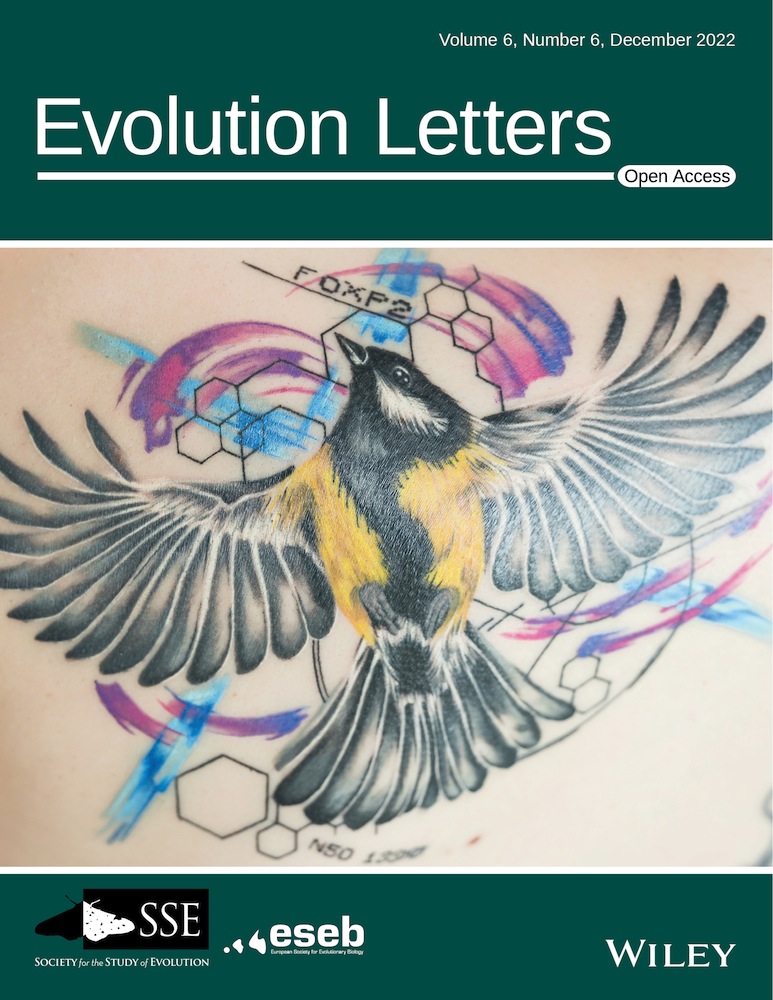协调照料可降低合作繁殖鸟类的冲突和捕食风险
IF 3.4
1区 生物学
Q2 EVOLUTIONARY BIOLOGY
引用次数: 0
摘要
当两个或更多个体合作供养共同的雏鸟时,每个照料者都可以通过协调其他人的供养工作,使自己的回报最大化。这种投资 "博弈 "不仅是投资多少的问题,也是投资相对时机的问题。最近的研究提出,以交替(即轮流照顾)和同步(即一起提供食物)形式出现的照顾时间协调,可分别缓解照顾者之间的冲突和降低雏鸟被捕食的风险。这种协调在双亲鸟类和合作繁殖鸟类中非常普遍,但其对健康的影响却很少经过实证检验。在这里,我们利用对长尾山雀(Aegithalos caudatus)的长期研究来评估这些假设的协调供应访问功能的支持情况。首先,我们发现了轮流照顾可以缓解照顾者之间冲突的证据,因为在合作群体中,随着照顾者表现出的积极交替水平以及照顾者之间供给率奇偶性的增加,供给率和后代招募率也随之增加。与此相反,在双亲巢中,后代招募并没有随着交替的增加而增加,尽管它与照料者之间的供给率奇偶性呈正相关,而这正是冲突缓解的结果。其次,同步访巢与巢被捕食的概率降低有关,从而提高了雏鸟的存活率,尤其是在供给率较高的情况下。我们将这一效应归因于同步减少了巢附近照料者的活动。我们的结论是,以交替和同步形式进行的时间协调性供给访问都会给照料者带来适应性益处,尽管这些不同类型的协调具有内在联系,但它们似乎发挥着不同的功能。本文章由计算机程序翻译,如有差异,请以英文原文为准。
Coordination of care reduces conflict and predation risk in a cooperatively breeding bird
When two or more individuals cooperate to provision a shared brood, each carer may be able to maximize their payoffs by coordinating provisioning in relation to what others are doing. This investment “game” is not simply a matter of how much to invest but also of the relative timing of investment. Recent studies propose that temporal coordination of care in the forms of alternation (i.e., turn-taking) and synchrony (i.e., provisioning together) function to mitigate conflict between carers and reduce brood predation risk, respectively. Such coordination is widespread in biparental and cooperatively breeding birds, yet the fitness consequences have rarely been empirically tested. Here, we use a long-term study of long-tailed tits Aegithalos caudatus, a facultative cooperatively breeding bird with active coordination of care, to assess the support for these hypothesized functions for coordination of provisioning visits. First, we found evidence that turn-taking mitigates conflict between carers because, in cooperative groups, provisioning rates and offspring recruitment increased with the level of active alternation exhibited by carers and with the associated increase in provisioning rate parity between carers. In contrast, offspring recruitment did not increase with alternation in biparental nests, although it was positively correlated with parity of provisioning between carers, which is predicted to result from conflict mitigation. Second, synchronous nest visits were associated with a reduced probability of nest predation and thus increased brood survival, especially when provisioning rates were high. We attribute this effect to synchrony reducing carer activity near the nest. We conclude that temporal coordination of provisioning visits in the forms of alternation and synchrony both confer fitness benefits on carers and despite being intrinsically linked, these different kinds of coordination appear to serve different functions.
求助全文
通过发布文献求助,成功后即可免费获取论文全文。
去求助
来源期刊

Evolution Letters
EVOLUTIONARY BIOLOGY-
CiteScore
13.00
自引率
2.00%
发文量
35
审稿时长
10 weeks
期刊介绍:
Evolution Letters publishes cutting-edge new research in all areas of Evolutionary Biology.
Available exclusively online, and entirely open access, Evolution Letters consists of Letters - original pieces of research which form the bulk of papers - and Comments and Opinion - a forum for highlighting timely new research ideas for the evolutionary community.
 求助内容:
求助内容: 应助结果提醒方式:
应助结果提醒方式:


